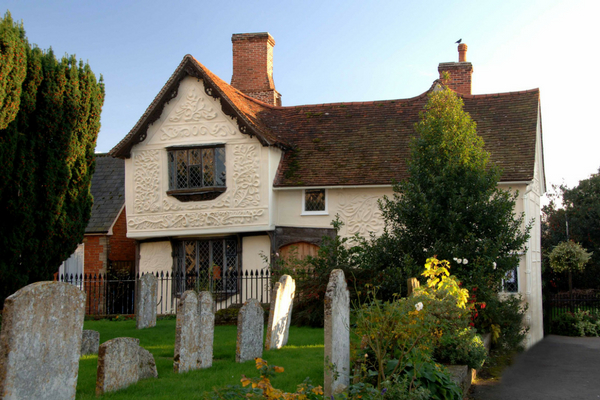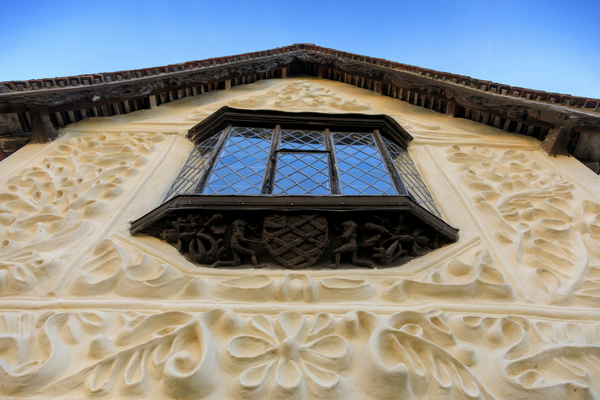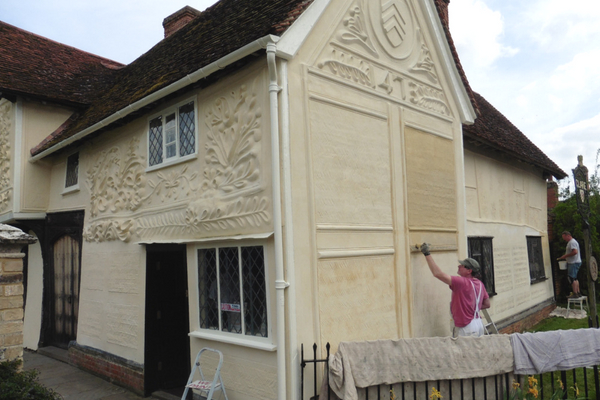
This small house, situated at the south-west corner of St Peter and St Paul’s churchyard in the village of Clare in Suffolk, is one of England’s best known examples of the art of pargeting (also spelt pargetting). The term is thought to derive from the French ‘parjeter’ or pargeter’ meaning to throw about. It refers to the vernacular technique of raised decorative plasterwork or render, usually applied to the outside of timber-framed buildings. It is particularly common in Suffolk and Essex, counties which have no local building stones apart from flint, and so has a great tradition of timber-framed buildings. Much pargeting is created using simple moulds or combs (even fingers!) to create geometric patterns on the wall surface such as chevrons, herringbones, rope patterns and interchanging squares.

But the Ancient House in Clare is a fine example of the much higher relief pargetting where the plaster is moulded by hand into elaborate three-dimensional designs. This work is done using lime rather than cement (which is too hard and results in cracking allowing moisture in), and often with the addition of horsehair, and the result is pleasantly soft and rounded. Small bundles of straw are sometimes used to help create the more projecting parts of a design. Other ingredients used in the past include urine, soot, dung, loam and blood.
Craftsmen such as Bill Sargent are masters of the craft of pargeting, helping to both conserve existing examples, but also regularly creating new work. Because it is an inherently fragile material and vulnerable to neglect, the more elaborate designs on older buildings like the Ancient House have often changed over time. For example, old engravings of the Ancient House show a ‘monster’ under the Museum’s first floor window in the front elevation, whereas now there is just a simple floral design.
The traditional finish for pargeting is to give it several costs of limewash – and the Ancient House has just had its pargeting repaired by one of our crack teams of decorators - Sam, Chas and Trefor, who all work for Abletex and who have worked on a large number of Landmarks over the years. The limewash was made and supplied by Ingilby Mariner just down the road near Sudbury. The mix has tallow added to it to increase its water resistance.

The Grade I listed house bears the date of 1473 in its pargetting but may well be older than this with the oldest section dating back to the 14th century. It was acquired by a local businessman in 1938 to prevent it from being dismantled and shipped to the USA – hard to imagine nowadays but certainly not unknown in the first half of the 20th century. He gave it to Clare Parish Council who now run a Museum about the history of the town and its inhabitants in the western part of the building, whilst the eastern half is the Landmark Trust part for just two lucky people. The ceiling in the sitting/dining room is another delight of the Ancient House with its moulded beams and joists with their charmingly carved leaf chamfer stops.
The Ancient House sleeps 2 and is available from £374.
Keep up with the latest Landmark news and offers
Sign up and receive information about:
- holidays in historic buildings
- building rescue projects
- key dates for advance bookings of our most popular Landmarks
- the latest Landmark news
Sign up